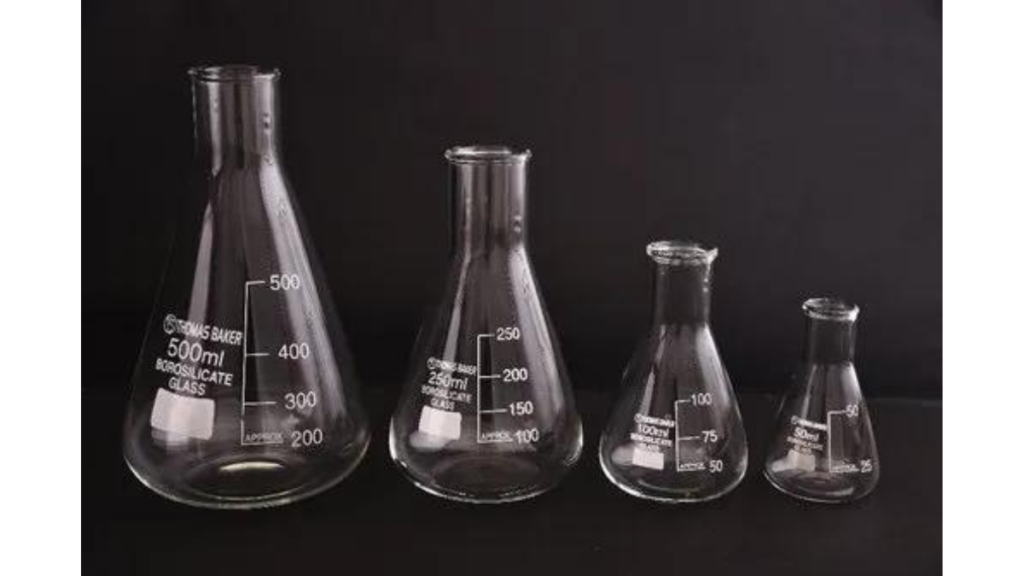The Erlenmeyer flask named after German chemist Emil Erlenmeyer, is a crucial laboratory glassware that has been instrumental in numerous scientific discoveries. Designed in the late 19th century, it features a conical shape, narrow neck, and wide base, making it an efficient vessel for various laboratory applications. Erlenmeyer flasks are made of borosilicate glass, known for its resistance to heat, chemicals, and thermal shock, making them suitable for both hot and cold applications.
Graduations and measurements are key features of the flask, allowing scientists to measure the volume of liquids with precision. The flask’s narrow neck accommodates a stopper or tubing for controlled gas release, making it ideal for gas-release reactions.
The flask has become a cultural symbol associated with scientific inquiry, often featured in scientific illustrations, educational materials, and popular media. Proper care and maintenance are essential for the flask’s longevity and accuracy. Regular cleaning with appropriate detergents, avoiding extreme temperature changes, and handling with care are crucial practices. Adherence to manufacturer’s guidelines ensures the flask’s continued reliability.
The Erlenmeyer flask is a testament to the importance of well-designed laboratory equipment and its versatility, durability, and cultural significance.
Origin and Design:
The Erlenmeyer flask was designed in the late 19th century by Emil Erlenmeyer as an improvement upon the traditional flat-bottomed flask. Its distinctive conical shape, narrow neck, and wide base make it a versatile and efficient vessel for a variety of laboratory applications. The sloping sides of the flask allow for easy swirling and mixing of liquids, while the narrow neck minimizes the risk of spills and splashes.
Material and Construction:
Erlenmeyer flasks are typically made of borosilicate glass, known for its resistance to heat, chemicals, and thermal shock. The sturdy construction of these flasks allows them to withstand a range of temperatures, making them suitable for both hot and cold applications. The flat bottom ensures stability on laboratory surfaces, and the neck can be fitted with a stopper or other closures as needed.
Graduations and Measurements:
One of the key features of the Erlenmeyer flask is the presence of graduated markings along its side. These markings allow scientists to measure the volume of liquids with precision. The graduations are especially useful in titrations, where accurate measurements are crucial for obtaining reliable results. The markings on the flask vary in volume, enabling scientists to use different-sized flasks for various experiments.
Versatile Applications:
Erlenmeyer flasks find application in a wide range of scientific disciplines, including chemistry, biology, and physics. They are commonly used for tasks such as mixing, titration, chemical reactions, and the cultivation of microorganisms. The shape of the flask is particularly advantageous in reactions that involve the release of gases, as the narrow neck can accommodate a stopper or tubing for controlled gas release.
Cultural Symbolism:
Beyond its practical uses, the Erlenmeyer flask has become a cultural symbol associated with scientific inquiry. Its distinctive silhouette is often featured in scientific illustrations, educational materials, and popular media, serving as a visual shorthand for laboratories and scientific experiments.
Care and Maintenance:
Proper care of Erlenmeyer flasks is essential for their longevity and accuracy. Regular cleaning with appropriate laboratory detergents, avoiding extreme temperature changes, and handling with care are crucial practices. Additionally, adherence to any specific guidelines provided by the manufacturer ensures the flask’s continued reliability.
Conclusion:
In the realm of scientific research, the Erlenmeyer flask stands as a testament to the importance of well-designed laboratory equipment. Its versatility, durability, and cultural significance make it an indispensable tool for scientists across various disciplines. As we continue to push the boundaries of scientific knowledge, the Erlenmeyer flask remains a steadfast companion in the pursuit of understanding the natural world.







